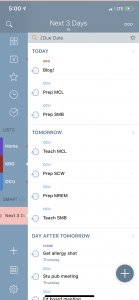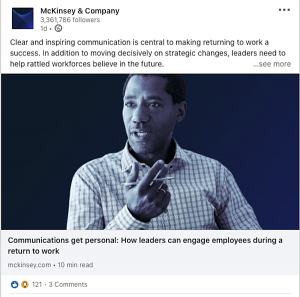Every agency wants that perfect client. The one that knows what they want, takes advice, and always brings work your way.
But while it would be nice if every interaction was this easy, you can’t just hope to find it every time. Sadly, not every relationship is built to last.
The good news is that there are some positive actions you can take to build better relationships with clients. The goal is to build functioning, lasting partnerships with clients who will happily come back to you in the future.
It takes effort on your part, but the reward is sustainable, enjoyable work for your agency’s future.
Here are 5 practical steps you can take to improve client relationships.
1. Set Clear Goals and Expectations
Goal-setting is essential for any campaign. If you don’t take the time to work out what you’re trying to achieve, and how you plan to achieve it, it’s nearly impossible to know whether your campaign is a success.
This is especially important when working on behalf of a client. Both parties need to take part in this process, to make sure that each knows what’s expected of the other.
There are a few key elements to this.
Break down the process fully
As a rule, it’s best to avoid surprises. Clients don’t need an agency that adapts well on the fly. They want an organized, well-oiled campaign.
Clearly explain how you work generally, and how you will work for this client specifically. What is your process, and why does it suit this campaign?
It’s also a great time to share case studies or examples from former clients. This will give them a better idea of what your specialties are, and will reassure them they’ve hired the right people.
You also need to explain what’s required from the client. When will you expect their input and feedback?
As Shayla Price writes, “agencies should identify customer touchpoints. Touchpoints are how your brand engages with the client.” These might be face-to-face meetings, weekly email updates, or creative direction at certain points in the campaign.
Identify these touchpoints from the beginning, so clients know when they can expect to hear from you, and what you need from them.
Create the gameplan together
You’re the expert, of course. But this is the client’s business, and you need them to feel confident and excited about the campaign you’re leading.
For this, they need to be involved in building a plan of attack. When they know what to expect, and they’ve been given a chance to contribute, it’s easier for them to let you work your magic.
This is especially important if you use a strategy that they may not know a lot about – inbound marketing for example. They have to know what your service will entail, not just the end goal.
This also gives you a sensible counter-argument when the client suddenly wants to change everything. For instance, when they rush into your office screaming “I just heard about this Snapchat thing! Let’s do it!”
You can calmly explain how Snapchat doesn’t make any sense for their brand, and besides, Snapchat won’t help them improve SEO (which was why they hired you). You can point to the plan you put together, and show them how this new development doesn’t fit.
Never bite off more than you can chew

A good rule in life, and a vital one in business. Nothing looks worse than failing to deliver on promises. This is a quick way to end a relationship with a valuable client.
Resist the urge to say “yes” to everything. Remember, you’re the expert, and they’ve hired you for a reason. Clients need direction, and want to feel that they’re in safe hands.
So feel confident setting boundaries – based on the client’s goals – and don’t overextend yourself.
2. Understand Your Client Better
In the early stages of a relationship, you need to commit time and energy to learning about your partners. At present, this is a significant challenge for agencies.
A report from Hall & Partners found three major issues with the average client relationship:
- Agencies do not understand their clients’ business
- Agencies do not understand their clients’ customers
- Agencies do not understand technology and innovation
These are big problems, and you need to make the effort to fix them. Here’s where to start.
Learn more about their business
To market or advertise a brand, you need to know a lot about it. Not just their products and customers, but their business model, their goals, and their challenges.
Ask your prospects (and new clients) the following questions:
- What is their business model?
- Where is their industry heading? What challenges do they anticipate?
- What are their main business goals?
- What are the biggest obstacles to achieving these goals?
- What is their definition of success? Both for their own company, and for this partnership.
The more you understand what matters to them, the better the service you can provide.
Understand their industry
For agencies focusing on a specific niche, this may not be a problem. But if you take on a client from an industry you’re not completely familiar with, you need to get up to speed quickly.
Media monitoring can help with this. Track online conversations around industry topics, and try to gauge public sentiment about similar products. This is a quick way to do market research before turning to time-consuming surveys and focus groups.
This is especially valuable for clients in controversial industries. You need to know what opponents, supporters, and the news media say in order to create appropriate creative work.
If you can speak authoritatively about your client’s industry, and show that you’ve done your homework, you increase your chances of building a lasting relationship.
Test out their product
This is almost essential. Even if you’re not their typical buyer, you want to know what a typical user experiences.
As Denise Williams says, “I work with ADT, so I have ADT service. When I worked with Verizon, I used a Verizon phone. I want to use and experience and feel the brand. People who don’t do that miss out on a lot of learning.”
You can also do a quick competitive analysis to learn more about your new client’s competition. This helps you see where they fit in the industry landscape, and identify any opportunities they may not be taking advantage of.
3. Work Together as Partners

A majority of digital agency clients say that their agency is more concerned with selling ideas than working together. At the same time, 54% of agencies feel that clients don’t view them as partners.
That can’t work in the long term. Clients need to feel respected for their input. It is their business, after all.
So how can you build a partnership?
Choose the right partners
For starters, you shouldn’t need to force a happy relationship. There will always be bumps in the road, but if you can identify good clients from the beginning, you’ll avoid the worst of them.
Seek out clients that make for a great fit straight off the bat. And on the flipside, turn away those that don’t suit your agency. It may be tough turning down a paycheck from time to time, but in the long run it’s worth it. An uneasy fit is a headache you don’t want to deal with.
If they tell you “we need someone who could do XYZ,” and you don’t do “Y,” that’s a major red flag. You’ll have the opportunity to clarify this with them, and make sure that the partnership makes sense in the long run.
Craft ideas together
We already talked about creating the gameplan together. But don’t stop there. One study found that 94% of agencies say start-to-finish collaboration is key to a great product, and 100% of clients agree. Which means that you need to involve the client throughout the process, from the very beginning.
Give the client a seat at the table. Not only is this good for the relationship, it can improve the end product: “No one person has a monopoly on creative thinking. We are all creative individuals, clients included.”
Communicate openly
You may think you’re already doing this well, and maybe you are. But there are positive steps you can take to make yourself more available:
- Be proactive. Anticipate issues and questions they’re going to have, and deal with them head on.
- Be honest. This can be hard, especially when something has gone wrong. But remember, the cover-up is always worse than the crime.
- Be transparent. Clients’ biggest concerns always include budget. Show them where their money goes and how much work you put in to deliver for them.
- Be receptive. It can be hard to hear criticism when you’ve slaved over something. But clients are more likely to bring more work your way if you’ve proven that you’ll deliver precisely what they want.
Clients who feel that they’re being listened to and respected are less likely to leave when the campaign is over.
4. Report Your Progress and Results
You already know that you need to report to clients during the campaign. But the frequency and quality of reporting can make a huge difference.
Clear reporting not only shows that you value the client, it also lets you prove how significant your progress has been. That in turn lets the client relax and trust in your services.
And trust is what we’re trying to encourage.
Make regular reporting a priority
Dun & Bradstreet writes that “agencies must lift barriers…by being fully transparent about the data used, tactics executed and metrics tracked.” This means communicating clearly – in plain language – and often with the client.
You don’t impress clients by using complicated terminology or overly stylized reports. Instead, focus on delivering statistics about their campaign at regular intervals, and allow them to ask questions when they need to.
The best approach is to make this part of the process from the beginning. Let them know “in advance of any agreement how [their] budget, timelines and KPIs will be tracked and reported and when.”
“Work in progress” meetings
I can already hear you screaming, “the last thing we need is more meetings!” And yes, meeting for the sake of meeting is harmful. But when the purpose is clear, and you’ve agreed to meet well in advance, these can be very productive.
The goal is to make sure that the client is aware and enthusiastic about the work done so far, and is excited about what’s to come. Keep them involved, and avoid surprises with regular catch-ups.
Automate reporting
Because reporting can sometimes feel like a necessary evil, let robots do the heavy lifting for you. There are great tools to help you do this.
For instance, if you’re tracking social media and web conversations, Mention lets you create automatic reports to send to clients periodically. Weekly, fortnightly, or monthly, Mention sends updates to any email address you choose:


Other tools like Cyfe or Klipfolio let you pull together statistics from all your different tools and display them on a central dashboard. These update in real-time, and you can share links to these with your clients.
If you can take the effort out of client reporting, you’ll have no option but to provide a better service to clients.
5. Deliver On Your Promises
We’ve all heard that agency catchphrase: “under-promise and over-deliver.” That’s all well and good, but the real goal should be: “set clear expectations and consistently achieve them.”
You can’t expect to maintain a healthy agency-client relationship if you don’t execute what you planned. That’s the quickest way to push valuable clients out the door.
We don’t need to go into great detail on this point. As Brian Honigman explains, “your word is your bond. Following up on your promises helps show the transparency of your business, while helping to build a feeling of trust and dependability with your audience.”
Business & Finance Articles on Business 2 Community
(85)







